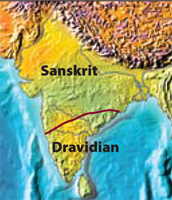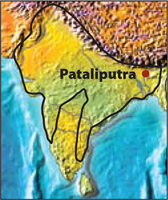
Of Kings and Prosperity
What You Will Learn...
Main Ideas
1. Ancient Indians regarded the subcontinent as one country.
2. From 300 to 1100 ce, India was a land of prosperity whose economic, religious and cultural influence extended across Asia.
3. Empires and kingdoms dominated most of India. Toward the end of this period, more regional powers emerged.
![]()
The Big Idea
![]() HINDUISM TODAY’S Teaching Standards
HINDUISM TODAY’S Teaching Standards
This column in each of the three sections presents our subject outline for India and Hinduism from 300 to 1100 ce.
1. Describe the physical and linguistic geography of India, along with population figures.
2. Describe the major empires and kingdoms, including the Guptas, Vakatakas, Chalukyas, Pallavas, Rashtrakutas, Pratiharas, Palas and Cholas.
3. Discuss the importance of Sanskrit and the Dharma Shastras in uniting India.
4. Describe India’s early Arab trade settlements and the later Islamic invasions.
If YOU lived then...
You live in a village in a small kingdom in central India. One day you hear that the king of a neighboring realm has attacked your king and conquered the royal city. The conquerer demands that your king pay a portion of his income. In return, he will allow your king to continue to rule, and also protect the kingdom from others.
Should your king accept the offer?
BUILDING BACKGROUND The 4th-century Vishnu Purana describes India: “The country that lies north of the ocean and south of the snowy mountains is called Bharata, for there dwelt the descendants of Bharata. It is the land of works, in consequence of which people go to heaven, and ultimately attain oneness with God.”
Understanding India
The triangle-shaped Indian subcontinent is naturally bounded by ocean on two sides and the high Himalayan mountains on the third. Hindu tradition, scriptures and the Sanskrit language link people from one end to the other of this immense and fertile area. Our period, 300 to 1100 ce, was a golden age in India. There was widespread prosperity and remarkable social stability. Advances were made in science, medicine and technology. Many Hindu saints lived during this time and magnificent temples were built. Hinduism as practiced today evolved over this glorious period of Indian history.
Geographical regions
There are three major geographical regions in India. The first region is the Indo-Gangetic Plain. This vast, fertile region stretches northeast and southwest along the base of the Himalayas. During our period, this area was heavily forested. The second region is the Deccan Plateau, bounded by the Vindhya mountain range in the north and the Nilgiri Hills in the south. It contains several major rivers and is rich in minerals. The third region is South India, the area south of the Nilgiri Hills extending to Kanyakumari at the tip of India. It has rich agricultural farm lands.

Language areas
India is divided linguistically into two major regions. In the north are mainly Sanskritbased languages, such as Hindi. In the south are the Dravidian languages, such as Tamil, which include many Sanskrit words. This division cuts across the middle of the Deccan Plateau. Often today when people speak of South India, they mean the Dravidian-speaking areas. These are the modern-day states of Andhra Pradesh, Karnataka, Kerala and Tamil Nadu. During our period, regional dialects developed within both the Sanskrit and Dravidian areas. Sanskrit was the language of religion, law and government throughout India. Travelers could use Sanskrit to communicate wherever they went on the subcontinent.
Empires and regional kingdoms

Linguistic Regions
In 300 ce, an estimated 42 million people lived in India, 23% of the world’s population of 180 million. Approximately 60% of the Indian people lived in the Indo-Gangetic Plain. There were many towns and cities, but more than 90% of the population lived in villages.

Gupta Empire: 300-550, with its capital at Pataliputra (present-day Patna)
As our period began, the Indo-Gangetic Plain again became the most important region of India, as it had been in the past. From 300 to 550, the Imperial Guptas established an extensive empire from the Himalayas deep into the south of India. Samudra Gupta (335-370) was the most heroic conqueror. The reign of his son, Chandra Gupta II Vikramaditya (375-414), was the most brilliant in the entire Hindu history. The Gupta kings granted local and regional autonomy. The frontier states were nearly independent. The empire was responsible for security, major roads, irrigation projects and common welfare.
The Guptas created both political and cultural pan-India unity. India made original literary, religious, artistic and scientific contributions that benefitted the entire known world. Chinese Buddhist monk Fa-hsien (Faxian) reported in the early 5th century, “In the cities and towns of this country, the people are rich and prosperous.” Hinduism thrived under the Guptas, taking forms which endure until today. Gupta culture and economy influenced much of Eurasia, notably China and Southeast Asia.
The Gupta Empire declined in the late 5th century because of internal strife and invasions by fierce Central Asian Hunas who ruled areas west of the Indus. The Hunas were driven back in the mid-6th century by emerging Hindu rulers.
During his 17-year journey through India, 7th century Chinese monk-scholar Hsuantsang (Xuanzang) wrote that there were about 70 regional powers. Many were part of the empire of King Harsha in the North and the major empires of the South.
In the 8th century, the Rashtrakutas took control of the entire Deccan, parts of West Central India and much of the South. Between the 8th and 10th centuries, they competed with the Pratiharas and Palas for pan-India dominance. The Pratiharas at their peak ruled much of northern India. They were the first to effectively stop Arab Muslim invasions into western India, holding them in check until the 10th century. The Palas, a Buddhist dynasty centered in eastern India, reached their zenith in the early ninth century. Then the Pratiharas displaced them from much of the Gangetic Plain.
There were several large Hindu kingdoms in the Deccan and South India in our period. They included the Vakatakas, Chalukyas, Pallavas and Pandyas. Rajendra Chola I, who ruled from 1014-1044, unified the entire South. The Cholas had a large army and navy. In an effort to protect their trade routes, they subdued kingdoms as far away as Malaysia and Indonesia. Their expeditions are unique in Indian history. The Cholas dominated trade between South India and the Middle East and Europe in the West, and Southeast Asia and China in the East. Indian traders brought Hindu religion and classical culture to Southeast Asia. Hindu and Buddhist kingdoms arose in present-day Malaysia, Indonesia, Thailand, Cambodia and South Vietnam.

Government and legal system
The kingdoms of India were guided by the Shastras, Hindu legal texts written in Sanskrit. The Dharma Shastras, such as Manu and Yajnavalkya, recorded laws and customs regarding family, marriage, inheritance and occupation, as well as suggested punishments for crimes. The Artha Shastra and Niti Shastras offered rules and advice on the king’s behavior, war, justice, administration and business regulation. People believed that when the king was brave and just, the kingdom prospered. Shastras, local customs, advice of the wise and sound judgment of the king together produced sophisticated, stable and enlightened government.
Muslim invasions
Arabia, where the new religion of Islam began in 610 ce, had long traded with India. Arab merchants belonging to Islam settled peacefully in South India in the early 7th century. By 711 Arab Muslim armies had conquered North Africa, Spain and the Persian empire. They attacked India’s frontiers as well. Arab Muslims conquered Sindh invasions were stopped by the Pratiharas, who confined Muslim rule to the Sindh region. Northwestern India remained stable under Hindu rule until the Turkish King, Mahmud of Ghazni (in modern Afghanistan), invaded India for plunder and the expansion of Islam. Ruling from 998-1030, Mahmud raided the country 17 times, wreaking large-scale destruction of temples, cities and palaces. The sack of the famed Siva temple of Somanatha in 1025 was the most horrific, involving the massacre of 50,000 defenders and the theft of fabulous wealth. This battle marked the beginning of Muslim domination of northwestern India.

REVIEWING IDEAS, TERMS AND PEOPLE
1. List: What are India’s major geographic regions?
2. Describe: Where did most Indians live in 300ce? What was it like? Who ruled this area at that time?
3. Explain: How did the Cholas succeed in unifying South India and spreading Hindu culture overseas?
4. Apply: What do you think are some rules and advice that the Shastras should give for kings?
5. Evaluate: If you ruled a kingdom that was attacked by a more powerful empire, would you fight back or try to join the empire? Why?
![]()
7. Analyze: Describe the Indian empires of the time and explain why they were attacked by Mahmud of Ghazni.
ACADEMIC VOCABULARY
autonomy
self-rule, independence
pan-India
relating to the whole of India
sack
to seize all valuables and destroy buildings
empire
a group of kingdoms under one authority
imperial
of, or relating to, an empire
plunder
property seized by violence
